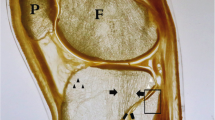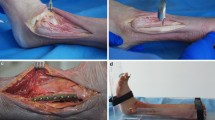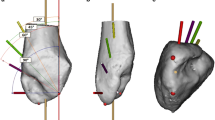Abstract
Introduction
Reduction of the distal fibula into the fibular notch (FN) poses a problem that has not been fully resolved, yet. A number of methods have been developed for the assessment of the position of the fibula in the FN, but none of them is ideal. A majority of authors assess the FN 1 cm above the tibiotalar joint space, without specifying the reason for the choice of this distance. None of the previous studies has addressed at what level the FN is the deepest. Our findings show that it is 4–5 mm above the ankle joint space and verification of this hypothesis has been the aim of this study.
Materials and methods
Dry adult tibial bone specimens from the Pachner’s collection of the Institute of Anatomy of 1st Faculty of Medicine, Charles University, Prague were used in the study. Height of the FN at its widest point, 3 mm and 10 mm above the articular surface of the distal tibia were measured in each specimen, as well as the depth of the FN at the deepest point, 3 mm and 10 mm above the articular surface of the distal tibia and the distance between the highest point of this surface and the deepest point of the notch.
Results
The mean length of the tibia was 350 mm; the mean height of the FN was 42.5 mm; the mean width of the FN at its widest point was 23.6 mm, at 3 mm above the tibiotalar joint space 22 mm, 10 mm above this articular surface of distal tibia (tibial plafond) 18.9 mm. The mean depth of the notch at 3 mm above the tibial plafond was 3.8 mm, at 10 mm above this surface 4.1 mm. The maximum mean depth of the notch was 4.5 mm, the distance from this point to the highest point of the tibial plafond was 5.3 mm.
Conclusion
The deepest point of the FN lies 5 mm above the articular surface of the tibial plafond, with the mean value of the depth being 4.5 mm. This region is, therefore, ideal for assessment of the position of the distal fibula in the FN.



Similar content being viewed by others
References
Bartoníček J (2003) Anatomy of the tibiofibular syndesmosis and its clinical relevance. Surg Radiol Anat 25:379–386
Bartoníček J, Rammelt S, Kostlivý K, Vaněček V, Klika D, Trešl I (2015) Anatomy and classification of the posterior tibial fragment in ankle fractures. Arch Orthop Trauma Surg 135:506–516
Bartoníček J, Rammelt S, Kašper Š, Malík J, Tuček M (2019) Pathoanatomy of Maisonneuve fracture based on radiologic and CT examination. Arch Orthop Trauma Surg 139:497–506
Boszczyk A, Kwapisz A, Krümmel M, Graas R, Rammelt S (2017) Anatomy of the tibial incisura as a risk factor for syndesmotic injury. Foot Ankle Surg 25:51–58
Boszczyk A, Kwapisz S, Krümmel M, Graas R, Rammelt S (2018) Correlation of incisura anatomy with syndesmotic malreduction. Foot Ankle Int 39:369–375
Brzobohatá H, Krajíček V, Velemínský P, Velemínská J (2019) Three-dimensional geometry of human tibial anterior curvature in chronologically distinct population samples of Central Europeans (2900 BC—21st century AD). Sci Rep 9:4234
Chen Y, Qiang M, Zhang K, Li H, Dai H (2015) A reliable radiographic measurement for evaluation of normal distal tibiofibular syndesmosis: a multi-detector computed tomography study in adults. J Foot Ankle Res 8:32
Cherney SM, Spraggs-Hughes AG, McAndrew CM, Ricci WM, Gardner MJ (2016) Incisura morphology as a risk factor for syndesmotic malreduction. Foot Ankle Int 37:748–754
Dalmau-Pastor M, Vega J (2017) Letter regarding: cadaveric analysis of the distal tibiofibular syndesmosis. Foot Ankle Int 38:343–345
Elgafy H, Semaan HB, Blessinger B, Wassef A, Ebraheim NA (2010) Computed tomography of normal distal tibiofibular syndesmosis. Skelet Radiol 39:559–564
Gupta C, Nayak N, Palimar V (2018) A morphometric study of incisura fibularis in south Indian population with its clinical implications. Int J Anat Appl Physiol 4:84–86
Hermans JJ, Beumer A, De Jong TA, Kleinrensink GJ (2010) Anatomy of the distal tibiofibular syndesmosis in adults: a pictorial essay with a multimodality approach. J Anat 217:633–645
Hu WK, Chen DW, Li B, Yang YF, Yu GR (2019) Motion of the distal tibiofibular syndesmosis under different loading patterns: a biomechanical study. J Orthop Surg (Hong Kong) 27:1–6
Kulkarni RR, Prakash ChR, Nidhi S (2012) Importance of fibular incisura measurements in ankle reconstructive surgeries. Int J AJ Inst Med Sci 1:80–85
Liu GT, Ryan E, Gustafson E, VanPelt MD, Raspovic KM, Lalli T, Wukich DK, Xi Y, Chhabra A (2018) Three-dimensional computed tomographic characterization of normal anatomic morphology and variations of the distal tibiofibular syndesmosis. J Foot Ankle Surg 57:1130–1136
Musa M, Pamela M, Moses O, Beda O, Gichambira G (2014) Morphometric characteristics of the fibular incisura in adult Kenyans. Anat J Afr 3:243–249
O´Sullivan E, Bowyer G, Webb AL (2013) The synovial fold of the distal tibiofibular joint: a morphometric study. Clin Anat 26:630–637
Park CH, Kim GB (2019) Tibiofibular relationships of the normal syndesmosis differ by age on axial computed tomography—anterior fibular translation with age. Injury 50:1256–1260
Prakash A (2017) Is incisura fibularis a reliable landmark for assessing syndesmotic stability? A systematic review of morphometric studies. Foot Ankle Spec 10:246–251
Sharif B, Welck M, Saifuddin A (2020) MRI of the distal tibiofibular joint. Skeletal Radiol 49:1–17
Sora MC, Strobl B, Stavkov D, Förster-Streffleur S (2004) Evaluation of the ankle syndesmosis: a plastination slices study. Clin Anat 17:513–517
Taser F, Toker S, Kilincoglu V (2009) Evaluation of morphometric characteristics of the fibular incisura on dry bones. Joint Dis Rel Surg 20:52–58
Tonogai I, Hamada D, Sairyo K (2017) Morphology of the incisura fibularis at the distal tibiofibular syndesmosis in the Japanese population. J Foot Ankle Surg 56:1147–1150
Yildirim H, Mavi A, Büyükbebeci O, Gümüsburun E (2003) Evaluation of the fibular incisura of the tibia with magnetic resonance imaging. Foot Ankle Int 24:387
Yu M, Zhang Y, Su Y, Wang F, Zhao D (2018) An anthropometric study of distal tibiofibular syndesmosis (DTS) in a Chinese population. J Orthop Surg Res 13:95–102
Funding
The project was supported by the AZV 16-28458A Grant—Trimalleolar ankle fractures—CT diagnosis of fractures of the posterior rim of the distal tibia, their classification, operative treatment.
Author information
Authors and Affiliations
Contributions
PF: data collection and analysis, manuscript preparation; KK: data collection and analysis; JB: project development, data collection and analysis, manuscript preparation; ON: data collection and analysis, manuscript preparation.
Corresponding author
Ethics declarations
Conflict of interest
The authors declare that they have no conflict of interests.
Ethical approval
The authors certify that the study was performed in accordance with the ethical standards as laid down in the 1964 Declaration of Helsinki and its later amendments.
Additional information
Publisher's Note
Springer Nature remains neutral with regard to jurisdictional claims in published maps and institutional affiliations.
Rights and permissions
About this article
Cite this article
Fojtík, P., Kostlivý, K., Bartoníček, J. et al. The fibular notch: an anatomical study. Surg Radiol Anat 42, 1161–1166 (2020). https://doi.org/10.1007/s00276-020-02476-w
Received:
Accepted:
Published:
Issue Date:
DOI: https://doi.org/10.1007/s00276-020-02476-w




